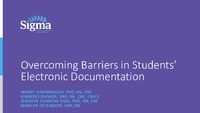| dc.contributor.author | Smith, Nicole Elena | en |
| dc.contributor.author | Ulicny, Mary Pat | en |
| dc.date.accessioned | 2016-08-11T16:05:42Z | |
| dc.date.available | 2016-08-11T16:05:42Z | |
| dc.date.issued | 2016-08-11 | |
| dc.identifier.uri | http://hdl.handle.net/10755/618318 | |
| dc.description | <p>Annual Simulation Conference. Held at the Gaylord Texan Resort & Convention Center</p> | en |
| dc.description.abstract | <p>Recommendations from The Institute of Medicine (IOM) call for wider use of information technology and use of electronic health record (EHR) systems to promote greater safety, quality and efficiency in health care delivery (Institute of Medicine [IOM], 2003). Nurses are constantly challenged to deliver safe, timely and efficient patient-care despite spending only 50 percent of their time at the patient’s bedside (Worth & Kennedy, 2008). Therefore, it is essential that nursing students be trained in academic institutions to be technologically literate through simulated EHRs. Navigating an EHR can cause confusion and frustration among first semester nursing students. Adopting a flipped classroom approach for laboratory courses requires students to submit weekly pre-lab activity assignments using an assigned patient in a simulated EHR. Examples of questions include: “Based on your patient’s last finger stick glucose result (view Flowsheet), refer to the Orders and MAR, how much regular insulin should be administered to your patient? Formative evaluation methods are used to evaluate the progression of student learning during a simulated medication administration experience. Application of EHR knowledge, psychomotor skills and assessment are applied to safe medication administration objectives in the course. Using a simulated EHR to flip the lab improves student confidence in navigating EHRs in a realistic way and assist faculty with ensuring students come to lab prepared. Students continue to build on meaningful EHR use throughout the program as a way to provide experiential learning that facilitates opportunities to provide safe care and improve patient outcomes.</p> | en |
| dc.format | Text-based Document | en |
| dc.language.iso | en | en |
| dc.subject | Clinical Simulation | en |
| dc.subject | Electronic Health Record | en |
| dc.subject | Formative Assessment | en |
| dc.title | Using a simulated EHR to flip the lab | en |
| dc.type | Presentation | en |
| dc.rights.holder | <p>
All rights reserved by the author(s) and/or publisher(s) listed in this item record unless relinquished in whole or part by a rights notation or a Creative Commons License present in this item record.
</p><p>
All permission requests should be directed accordingly and not to the Sigma Repository.
</p><p>
All submitting authors or publishers have affirmed that when using material in their work where they do not own copyright, they have obtained permission of the copyright holder prior to submission and the rights holder has been acknowledged as necessary.
</p> | en |
| dc.description.note | <p>Items submitted to a conference/event were evaluated/peer-reviewed at the time of abstract submission to the event. No other peer-review was provided prior to submission to the Henderson Repository, unless otherwise noted.</p> | en |
| dc.type.category | Full-text | en |
| dc.evidence.level | N/A | en |
| dc.research.approach | N/A | en |
| dc.author.details | Nicole E. Smith, MS, RN, CNE; Mary Pat Ulicny, MS, MHA, RN, CNE | en |
| dc.conference.name | International Nursing Association for Clinical Simulation and Learning Annual Conference 2016 | en |
| dc.conference.host | International Nursing Association for Clinical Simulation and Learning | en |
| dc.conference.location | Grapevine, Texas, USA | en |
| dc.date.conferenceyear | 2016 | |
| dc.contributor.affiliation | International Nursing Association for Clinical Simulation and Learning (INACSL) | en |
| dc.description.reviewtype | Abstract Review Only: Reviewed by Event Host | en |
| dc.description.acquisition | Proxy-submission | en |





